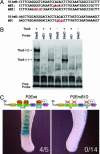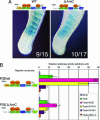Tbx6-mediated Notch signaling controls somite-specific Mesp2 expression
- PMID: 16505380
- PMCID: PMC1450137
- DOI: 10.1073/pnas.0508238103
Tbx6-mediated Notch signaling controls somite-specific Mesp2 expression
Abstract
Mesp2 is a transcription factor that plays fundamental roles in somitogenesis, and its expression is strictly restricted to the anterior presomitic mesoderm just before segment border formation. The transcriptional on-off cycle is linked to the segmentation clock. In our current study, we show that a T-box transcription factor, Tbx6, is essential for Mesp2 expression. Tbx6 directly binds to the Mesp2 gene upstream region and mediates Notch signaling, and subsequent Mesp2 transcription, in the anterior presomitic mesoderm. Our data therefore reveal that a mechanism, via Tbx6-dependent Notch signaling, acts on the transcriptional regulation of Mesp2. This finding uncovers an additional component of the interacting network of various signaling pathways that are involved in somitogenesis.
Conflict of interest statement
Conflict of interest statement: No conflicts declared.
Figures





Similar articles
-
Functional importance of evolutionally conserved Tbx6 binding sites in the presomitic mesoderm-specific enhancer of Mesp2.Development. 2008 Nov;135(21):3511-9. doi: 10.1242/dev.027144. Development. 2008. PMID: 18849530
-
Mesp2 and Tbx6 cooperatively create periodic patterns coupled with the clock machinery during mouse somitogenesis.Development. 2008 Aug;135(15):2555-62. doi: 10.1242/dev.019877. Epub 2008 Jun 25. Development. 2008. PMID: 18579680
-
Transgenic analysis of the medaka mesp-b enhancer in somitogenesis.Dev Growth Differ. 2006 Apr;48(3):153-68. doi: 10.1111/j.1440-169X.2006.00853.x. Dev Growth Differ. 2006. PMID: 16573733
-
Segmental border is defined by the key transcription factor Mesp2, by means of the suppression of Notch activity.Dev Dyn. 2007 Jun;236(6):1450-5. doi: 10.1002/dvdy.21143. Dev Dyn. 2007. PMID: 17394251 Review.
-
The mechanism of somite formation in mice.Curr Opin Genet Dev. 2012 Aug;22(4):331-8. doi: 10.1016/j.gde.2012.05.004. Epub 2012 Jun 27. Curr Opin Genet Dev. 2012. PMID: 22742849 Review.
Cited by
-
Smad6 inhibits the transcriptional activity of Tbx6 by mediating its degradation.J Biol Chem. 2009 Aug 28;284(35):23481-90. doi: 10.1074/jbc.M109.007864. Epub 2009 Jun 26. J Biol Chem. 2009. PMID: 19561075 Free PMC article.
-
Signalling dynamics in vertebrate segmentation.Nat Rev Mol Cell Biol. 2014 Nov;15(11):709-21. doi: 10.1038/nrm3891. Nat Rev Mol Cell Biol. 2014. PMID: 25335437 Review.
-
From segment to somite: segmentation to epithelialization analyzed within quantitative frameworks.Dev Dyn. 2007 Jun;236(6):1392-402. doi: 10.1002/dvdy.21199. Dev Dyn. 2007. PMID: 17497694 Free PMC article. Review.
-
Teasing out T-box targets in early mesoderm.Curr Opin Genet Dev. 2008 Oct;18(5):418-25. doi: 10.1016/j.gde.2008.07.017. Epub 2008 Sep 7. Curr Opin Genet Dev. 2008. PMID: 18778771 Free PMC article. Review.
-
Differentiation of pluripotent stem cells to muscle fiber to model Duchenne muscular dystrophy.Nat Biotechnol. 2015 Sep;33(9):962-9. doi: 10.1038/nbt.3297. Epub 2015 Aug 3. Nat Biotechnol. 2015. PMID: 26237517
References
-
- Huppert S. S., Ilagan M. X., De Strooper B., Kopan R. Dev. Cell. 2005;8:677–688. - PubMed
-
- Morimoto M., Takahashi Y., Endo M., Saga Y. Nature. 2005;435:354–359. - PubMed
-
- Aulehla A., Wehrle C., Brand-Saberi B., Kemler R., Gossler A., Kanzler B., Herrmann B. G. Dev. Cell. 2003;4:395–406. - PubMed
-
- Sawada A., Shinya M., Jiang Y. J., Kawakami A., Kuroiwa A., Takeda H. Development. 2001;128:4873–4880. - PubMed
Publication types
MeSH terms
Substances
LinkOut - more resources
Full Text Sources
Molecular Biology Databases

